Best Skateboard for Surfing: A Comprehensive Guide
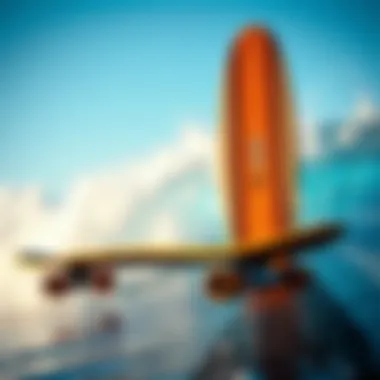
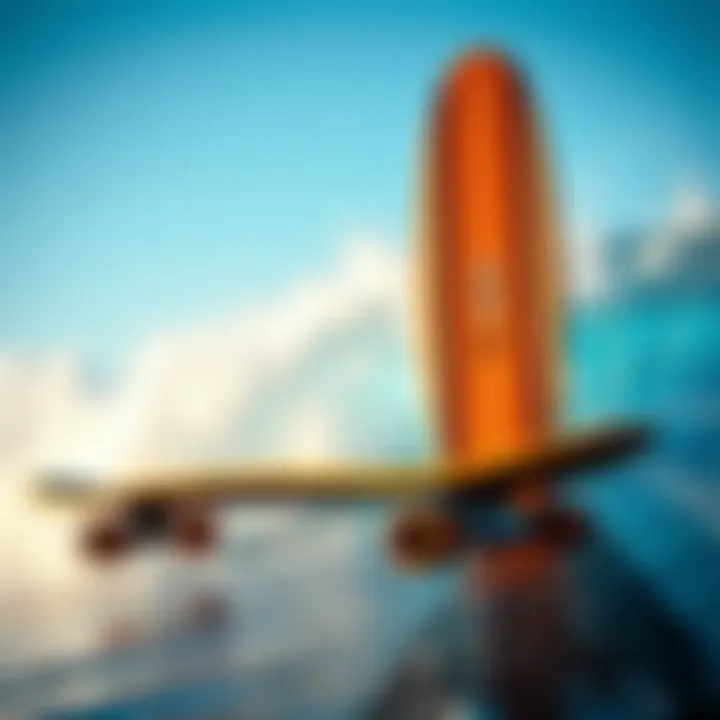
Intro
Skateboarding has evolved from a simple pastime to an expressive medium that draws inspiration from multiple sports. One of the more fascinating trends is the connection between skateboarding and surfing. Though they occur in different environments, the two share a philosophy that embraces fluidity, creativity, and freedom. Skateboarders who love to surf often look for ways to replicate that unique sensation on solid ground. This guide aims to shine a light on the best skateboards for surfing enthusiasts who wish to ride the waves of creativity and motion while they’re off the beach.
There’s a special kind of joy that comes from capturing the essence of surfing with wheels. Whether you’re an experienced surfer trying to bring your ocean skills inland or a beginner eager to explore what it feels like to carve through the asphalt, the right skateboard can make all the difference. We’ll dive deep into specific skateboard types, the features you ought to keep an eye on, and how those attributes align with different surfing techniques.
Through this article, we won’t just stop at specs; instead, we’ll explore how each board fits into the broader context of skateboarding and surfing. Along the way, we’ll cover action-packed surfing techniques that can adapt to land riding and suggest equipment meant to enhance your overall experience. Our goal is to arm you with information that helps you select a skateboard tailored to your specific needs, enabling you to recreate that surf vibe even when you're miles from the shore.
Understanding the Connection Between Skateboarding and Surfing
Skateboarding and surfing, although practiced on different terrains, share a deep-rooted bond that transcends mere recreational activities. Both sports demand a unique blend of balance, agility, and an innate understanding of flow, making their connection a pivotal point for riders seeking to emulate the thrill of hanging ten on asphalt.
When examining the connection, it becomes evident that both skateboarding and surfing prioritize similar mechanics. Riders are not merely moving; they're navigating. The way a skateboarder shifts their weight to carve a turn mirrors how a surfer balances on a wave. Understanding this connection helps riders appreciate the learning curve they may face when transitioning between the two sports.
Additionally, this relationship creates numerous benefits. For instance, practicing skateboarding can enhance a surfer's balance and stance stability. It allows for the honing of techniques that will ultimately improve their abilities when they hit the waves. This dual practice can be invaluable during months when conditions for surfing aren't ideal or when access to oceans is limited.
Benefits of Understanding the Connection:
- Enhanced Balance: Both sports require core strength and stability, contributing to overall proficiency.
- Improved Techniques: Techniques learned in one sport can often be translated to the other, fostering adaptability.
- Full-Body Workout: Engaging in both activities provides a comprehensive workout regime, targeting various muscle groups.
Defining Characteristics of the Best Skateboards for Surfing
When searching for the ideal skateboard to replicate the feel of surfing on land, understanding the defining characteristics is crucial. These elements significantly impact performance, board handling, and overall enjoyment. Features such as deck shape, flexibility, wheel type, and size play a vital role in how closely a skateboard can simulate the fluid movements of surfing.
Choosing the right characteristics not only enhances the riding experience but also ensures that riders can execute techniques akin to those on the water. Let's dive deeper into each of these characteristics to figure out how they contribute to a surf-like skateboarding experience.
Deck Shape and Flexibility
The shape of a skateboard deck can influence riding in profound ways. A wide deck provides stability, while narrower decks may allow for sharper turns. The most surf-friendly shapes often mimic the contours of a surfboard.
Key Elements of Deck Shape:
- Nose and Tail Design: These can either facilitate sharper maneuvers or float through smooth curves, directly impacting how a rider shifts their weight. A pointed nose mimics a surfboard better than a square one.
- Concave Depth: A deeper concave helps lock in the feet, allowing for better control while carving, paralleling the experience of a bottom turn or cutback in surfing.
- Flexibility: A flexible deck can absorb shocks better, promoting smoother rides over rough surfaces. This flexibility mirrors the responsiveness of a surfboard on waves, enabling the rider to adjust their stance and weight dynamically—as if they're really gliding on water.
In essence, a skateboard deck that balances all these factors can significantly enhance a rider’s experience by making it feel much closer to the real thing.
Wheel Type and Size
Wheels are often an underestimated but crucial aspect of any skateboard, especially for those looking to simulate surfing. The type and size of wheels affect speed, grip, and the overall feel of the ride.
Considerations for Wheel Selection:
- Durometer (Hardness): Softer wheels (78A to 87A) are typically better for cruising and provide a smoother ride over rougher terrains, replicating the feel of riding through choppy waters. Harder wheels (89A+) are generally faster on smooth surfaces but offer less grip, which can lead to slips.
- Diameter: Larger wheels (55mm and above) tend to roll over obstacles better and provide increased stability, similar to maintaining balance on a surfboard riding on waves. Smaller wheels offer better tricks but less smoothness over uneven surfaces.
- Shape: Wider wheels offer more grip, which is essential when carving tight turns or performing tricks that require strength and balance, akin to maneuvering a surfboard.
These characteristics of wheels, when thoughtfully selected, can create an experience that closely aligns with the nuances of riding a surfboard, ensuring a satisfying ride whether gliding through the streets or hitting a skate park.
As the lines between skateboarding and surfing blur, recognizing these features empowers riders to select the best skateboard to suit their unique surfing styles and techniques, setting the stage for an exhilarating journey on land.
Types of Skateboards Suited for Surfing Simulation
Skateboarding and surfing share a deep-rooted connection that extends beyond mere aesthetics; they're both about balance, flow, and a certain rhythm with the environment. Selecting the right skateboard that simulates surfing techniques can significantly enhance your riding experience. Various types of skateboards cater to this need, each offering distinct advantages depending on one's preferences and skill level. Let’s take a closer look at these types and their suitability for simulating the exhilarating sensations of surfing.
Longboards and Their Advantages
Longboards are are often considered the quintessential choice for those seeking to replicate the glide of surfing on land. Their extended decks allow for more foot space, making it easier to shift weight as one would when carving a wave. A few advantages stand out:
- Stability: The longer wheelbase offers more stability, which is crucial for beginners still finding their footing.
- Smooth Ride: Larger wheels absorb bumps and uneven terrains better than traditional skateboards, enhancing the overall ride quality, especially on pavements reminiscent of ocean swells.
- Flow: The design encourages smooth transitions and flowing movements, which mirror the natural ebb and flow of surfing.
However, it's essential to consider the terrain where you’ll be riding. Longboards are best suited for flat surfaces; hence, they might not be ideal for trick-heavy environments.
Surfskate Boards
Surfskate boards are a hybrid designed specifically to mimic the sensations and movements of surfing. With a unique front truck system that allows for exaggerated turns and carving, these boards recreate the surfer's twists and curves on a wave. Here are a few key points:
- Enhanced Maneuverability: The front truck is usually mounted on a pivoting mechanism, allowing for tighter, surf-like turns that feel authentic.
- Dynamic Feedback: The board responds quickly to weight shifts, similar to how a surfer shifts their body to control direction and speed on a wave.
- Performance on Variety of Terrains: Surfskates can perform well on both smooth and slightly textured surfaces, though the experience is most thrilling on wider expanses.
Surfskate boards are becoming increasingly popular among surfers who want to improve their carving and turning skills even when they can't hit the water.
Mini Skateboards
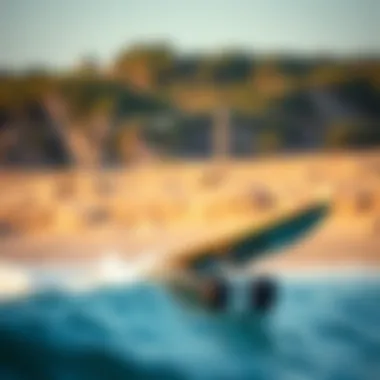
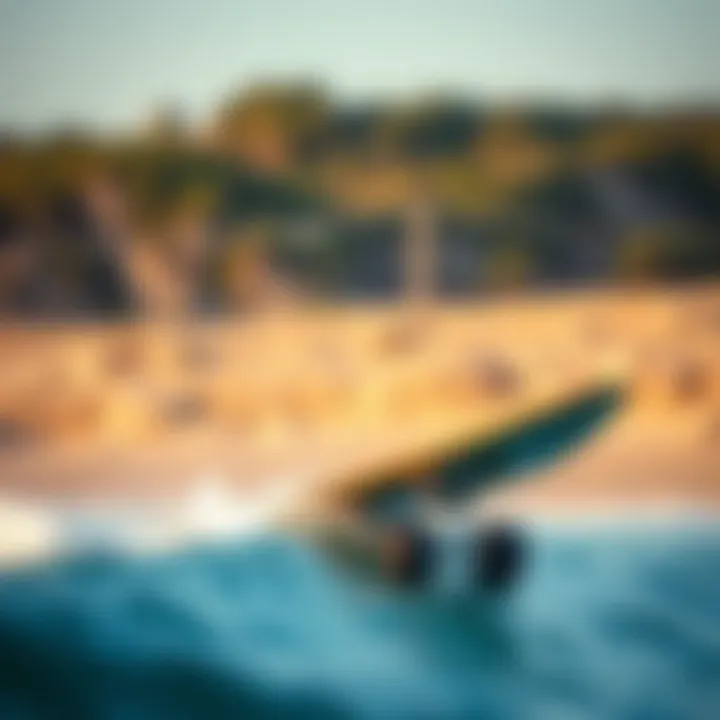
Mini skateboards, though not as commonly associated with surfing, can also provide a distinctive experience suitable for certain skateboarding styles. Offering a compact design, they can easily be maneuvered in tight spaces and are often favored by younger riders. Key attributes include:
- Portability: Their smaller size makes them incredibly easy to carry, perfect for those impromptu sessions down at the park or urban settings.
- Quick Tricks: Mini boards allow for more rapid movements and tricks; their lightweight nature contributes to easy flips and spins. This is perfect for riders looking to add some flair to their style while learning.
- Affordable Investment: Typically more budget-friendly, mini skateboards can be a great entry point for riders hoping to transition into longer boards later on.
While mini skateboards might not replicate the surfing experience as effectively, they’re still an option for riders who enjoy a playful take on skateboarding.
In summary, understanding the types of skateboards suited for surfing simulation is vital in finding your ideal match. Each type—the longboard, surfskate board, or mini skateboard—offers unique benefits that align with the various styles of riding inspired by surfing. With the right skateboard in hand, you can carve the asphalt just like you would the waves.
Key Features to Consider When Choosing a Skateboard
When it comes to picking the perfect skateboard that brings the thrill of surfing to land, understanding the key features can spell the difference between a ride that feels right and one that leaves you feeling off-kilter. While many may think it’s all about aesthetics, features like trucks and grip tape are foundational elements that can significantly influence performance and overall enjoyment.
Trucks and Their Influence on Turning
The trucks of a skateboard are primary as they connect the deck to the wheels. Made of a metal alloy, they play a crucial role in how well you can turn and maneuver. Understanding truck specifications is essential for a surfer transitioning to skateboarding.
- Width: The width of the trucks should match the width of the deck. A wider truck enhances stability, while a narrower truck can make for sharper turns. Many surfers prefer wider trucks to mimic the stable feel of a surfboard.
- Baseplate Design: The baseplate refers to the part of the truck that sits on the skateboard deck. Some skateboards feature a higher baseplate that allows deeper turns, akin to a bottom turn in surfing. This is perfect for individuals aiming to replicate surf techniques while on land.
- Kingpin Angles: The angle of the kingpin, which holds the truck components together, is another crucial factor. Slanted angles allow for more fluid turns. Consider experimenting with different setups to find what feels best for your riding style.
In essence, trucks dictate your turning ability, and finding a truck configuration that feels natural can elevate your skateboarding experience.
Grip Tape Quality
The quality of grip tape is often overlooked, but it's a detail that can transform your riding experience. Grip tape is what keeps your shoes glued to the board, especially during maneuvers that require balance and control.
- Surface Texture: A grittier surface often provides better traction, which is essential when performing tricks or navigating sharp turns. While you want stickiness, it should not be so coarse that it wears down your shoes quickly.
- Thickness: Standard grip tape thickness hits the right mark for most riders, but some prefer a thinner version for a more responsive feel. Testing multiple thicknesses can help determine your ideal choice.
- Design and Aesthetics: Though functionality is key, a skateboard deck should resonate with your personal style. Many brands offer different designs and colors on their grip tape, allowing riders to express themselves while enjoying the functional benefits.
Good grip tape ensures that your feet remain in a steady position while skating. This is particularly essential as you begin to incorporate surfing techniques into your skateboarding routine. A solid grip can effectively bridge the gap between the dynamics of skating and surfing, making for a seamless and engaging experience.
"Choosing the right trucks and grip tape is like finding the perfect fin setup on a surfboard; it can completely reshape your ride."
To wrap it all up, the trucks and grip tape are not just details; they are crucial components that directly influence your performance on a skateboard that aims to emulate the surfing experience. By paying attention to these features, you will undoubtedly take significant strides in bridging the gap between skating and surfing.
Top Skateboard Brands for Surfing Styles
When it comes to selecting the best skateboard for simulating the surfing experience, brand reputation plays a formidable role. A brand is not just a name; it embodies quality, reliability, and innovation. Enthusiasts often gravitate towards brands known for their craftsmanship and performance. It’s essential to recognize that the right skateboard can profoundly affect your ride and mimic the surfing styles you aim to replicate.
Ultimately, some brands resonate more with the surfing community than others, largely due to their commitment to producing high-quality equipment that endures the test of both time and terrain.
Brand Reputation and User Reviews
Brand reputation is critical in the skateboarding realm. Users rely heavily on reviews to gauge performance and durability. Brands like Sector 9 and Globe are household names, often praised for their dedication to creating skateboards that blend with surfing techniques seamlessly. Their user reviews often highlight not just the aesthetics of the boards but also their practical functionality and adaptability on varied surfaces, which is crucial for resembling the surf experience.
A significant advantage of checking reviews is learning from the experiences of others. Many surfers-turned-skaters share insights about how certain boards adapt to tricks or how well they handle during turns. For instance, a solid review might state, "I’ve used the Sector 9 longboard for months now, and it glides over cracks like a fish on waves."
Such personal stories, preferences, and critiques offer a glimpse into how diverse boards cater to different levels of riders, enhancing one’s decision-making process effectively.
Product Variety Among Brands
Variety is the spice of life, especially concerning skateboards. Not every skater has the same style or needs, so brands that offer a broad range of products are likely to steal the show. Let’s take Carver Skateboards for example; they specialize in surfskates designed to imitate the carving motion of surfing. On the other hand, brands like Landyachtz provide versatile boards suited for both tricks and casual cruising.
Moreover, the selection of colors, materials, and designs reflects the individuality of surfers. Whether you prefer a minimalist design or a deck plastered with vibrant artwork, various brands cater to different tastes.
- Carver Skateboards: Known for surfskates that enhance carving.
- Landyachtz: Offers a mix of cruiser and trick options that cater to various riding styles.
- Globe: Balances affordability with performance, featuring boards for beginners and seasoned skaters alike.
- Arbor Collective: Committed to sustainability, their boards appeal to environmentally conscious riders, showcasing beautiful wood craftsmanship.
To sum it up, understanding the brands and the variety they offer is indispensable when choosing a skateboard. Confidently riding a board designed for your individual style can work wonders for both your skill development and overall enjoyment. By recognizing these key factors, you set the stage for a more fulfilling skateboarding experience that echoes the euphoria of surfing.
Skill Levels and Suitable Skateboard Recommendations
Choosing the right skateboard based on skill level is crucial for both beginners and seasoned riders. Selecting a board that aligns with one’s experience can significantly affect performance and enjoyment. Understanding how skill levels influence the type of skateboard needed helps riders make informed decisions that can enhance their overall skating experience.
Beginners: Finding the Right Fit
For those just starting on their skateboarding journey, finding the right fit is akin to picking a good pair of shoes. A starter skateboard should ideally promote stability, ease of control, and comfort, paving the way for confidence and a hunger to learn. Basic features to look for include:
- Wider Decks: A wider board provides a stable base, making it easier to balance and manage. This helps beginners focus on learning fundamental techniques without feeling wobbly.
- Soft Wheels: Softer wheels absorb bumps and vibrations, thereby providing a smooth ride, particularly important for new riders who might not yet have perfected their balance.
- Reliable Trucks: Quality trucks that support the board’s weight and allow for easy steering are essential. They should not be too tight, as that can make turning more difficult for inexperienced riders.
"A beginner’s success in skateboarding often stems from a skateboard that feels natural and comfortable beneath their feet."
Choosing a pre-assembled complete skateboard instead of trying to piece it together can also simplify the process. This way, newcomers can focus on practicing rather than dealing with tech issues right off the bat.
Intermediate to Advanced Skateboarders
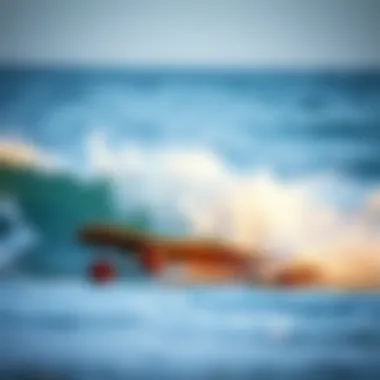
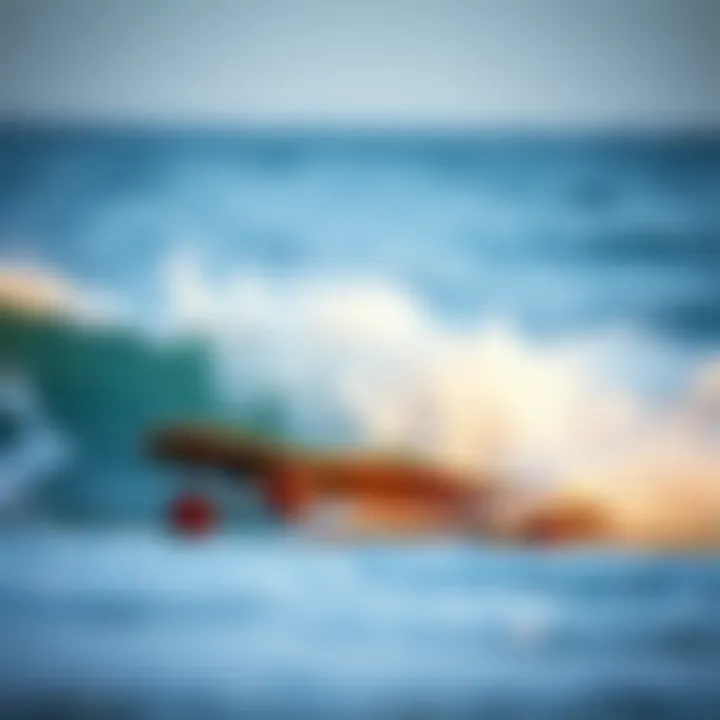
For those with a bit more experience, the skateboard becomes more than just a mode of transport; it becomes a key tool for expressing their skills. Intermediate and advanced riders often seek boards that cater to their specific style, maneuvers, and the kind of terrain they prefer. Some suitable features include:
- Narrower Decks: These allow for quicker maneuvers and tricks, appealing to riders looking to express their creativity through technical skating.
- Harder Wheels: These provide a faster ride on smooth surfaces, perfect for street or park skating. They also enhance control during tricks.
- Responsive Trucks: More sensitive trucks can improve responsiveness when turning or doing tricks, an element that higher-skilled riders usually demand.
Intermediate and advanced skateboarders should also consider the terrain they plan to navigate. Skateboards designed for cruising on smooth pavements differ significantly from those built for skate parks or rougher conditions. Whether focused on technical tricks, transition skating, or enjoying a smooth ride, selecting the right components can elevate one’s performance and satisfaction.
In summary, whether you're just stepping onto a board or are skilled enough to land a few tricky stunts, it's important to select a skateboard that aligns with your skill set. Not only does it aid in mastering the basics, but it transforms your entire experience on four wheels, setting you on a path toward expertise in both skateboarding and its beautiful relation to surfing.
The Role of Terrain in Skateboard Selection
Selecting a skateboard involves not just aesthetics or brand loyalty, but it heavily hinges on the terrain where you'll be utilizing it. Each surface type poses unique challenges and advantages that directly influence the sort of skateboard you should go for. Understanding how terrain affects your skateboarding experience is crucial, especially for those looking to mimic the surfing experience on land.
Terrain determines how your skateboard performs in terms of grip, speed, and maneuverability. If you're skating in an urban environment filled with smooth pavements and ramps or tackling rugged outdoor trails, your choice of skateboard needs to account for those differences. Ignoring this aspect could lead to subpar experiences, and ultimately, frustration when you're trying to master skills borrowed from surfing.
Pavement vs. Rough Surfaces
The most common surface for skateboarding is pavement. Smooth, well-maintained asphalt provides minimal resistance, allowing skaters to achieve higher speeds with ease. This is where a regular skateboard shines, especially if the board is equipped with softer wheels that absorb vibrations. Softer wheels are ideal if you plan to cruise around town or glide along the beach promenade, emulating the smooth turns of a surfing ride.
On the flip side, rough surfaces require a different approach. Take, for example, gravel-strewn paths or uneven terrain in parks. Here, a more robust setup is necessary. Longboards or specialized off-road skateboards come into play, as they are generally designed to withstand the bumps and dips of such terrain. Their larger wheels and flexible decks can absorb the shocks, making skimming over rugged ground comparable to grabbing a wave and riding it out.
"Choosing the right skateboard for the terrain not only enhances your performance but also prolongs the lifespan of your equipment."
To summarize the differences:
- Pavement: Encourages higher speeds, smooth rides. Regular skateboards with softer wheels often excel here.
- Rough Surfaces: Demand sturdier boards, often with larger, tougher wheels. Opt for off-road boards or longboards to handle the bumps.
Urban vs. Off-Road Experiences
When considering urban terrain, it's essential to factor in the type of obstacles and street setups you're likely to encounter. Urban environments are a playground of rails, curbs, and ramps. Here, maneuverability becomes paramount. Skateboards designed for street skating generally feature smaller wheels and shorter decks, allowing for precise control and agility. Techniques like street tricks and ollies become more attainable when you have a board matched to the urban landscape.
Conversely, off-road experiences are an entirely different story. If you're venturing onto trails or unpaved paths, you need a skateboard that can tackle inclines, declines, and unpredictable surfaces. Off-road skateboards usually come with larger, knobby tires and sturdier frames to withstand soft earth or rugged rocks. This setup offers stability and traction, essential for maintaining control in such environments.
Caring for Your Skateboard to Maintain Performance
Taking care of your skateboard is akin to maintaining a well-loved surfboard. If you want to keep gliding smoothly on your land waves, you need to regularly check in on your gear. Skateboards endure enough wear and tear as it is, and if you want them to continue capturing that elusive flow found when riding the surf, proper maintenance is non-negotiable. When you give your skateboard the attention it deserves, you're not only prolonging its life but enhancing your ride experience.
The components of a skateboard—just like the wheels, fins, and tail of a surfboard—must be in tip-top shape for optimal performance. Whether it's the grip tape getting slick, or the trucks becoming squeaky, each part plays a vital role. Neglecting these small issues can snowball into bigger complications down the road.
Regular Maintenance Tips
Maintaining your skateboard shouldn't feel like a chore. It can be straightforward if you make it a habit. Here are some steps that'll keep your board performing like a dream:
- Check the grip tape: Make sure it’s not worn down. If it loses traction, it could spell trouble. A quick wipe with a damp cloth can help. If it’s peeling or damaged, it’s a good idea to replace it.
- Inspect the wheels: Look for flat spots and check if they roll freely. Dirt and grime can build up, hindering performance. A wash with some warm soapy water does wonders.
- Tighten the trucks: If your board feels loose, check that the hardware is tightened to your liking. Remember, a tighter truck can mean stability, while looser trucks can give you more maneuverability.
- Lubricate bearings: After some time, they might choke on debris, so cleaning and putting some skateboard-specific lubricant can keep them functioning well. This will add years to their life.
"A well-cared skateboard is the heart of smooth surfing on land."
Storage and Care Considerations
The way you store your skateboard can have lasting effects on its components. If you’re looking for longevity, heed the following storage advice:
- Keep it indoors: Avoid leaving your skateboard outside where it can be exposed to the elements. Whether it’s rain or intense sun, these factors deteriorate materials quickly.
- Avoid extreme temperatures: Just like a surfboard, a skateboard is sensitive to temperature changes. Keeping it in a stable environment helps in maintaining the integrity of the wood and other materials.
- Use a skateboard bag: If you travel with your board—whether heading to the skate park or the beach—a padded skateboard bag protects it from bumps and scrapes.
- Store it vertically when possible: This prevents warping of the deck and keeps the wheels intact as they don't bear unnecessary pressure.
By embracing these maintenance practices, you set the stage for an enjoyable riding experience. Taking some simple steps to care for your skateboard allows you to maximize your performance while enjoying the thrill reminiscent of riding waves.
Legal Considerations for Skateboarding in Public Spaces
When it comes to skateboarding, especially in public areas, knowing the legal landscape is crucial. The intersection of laws and skateboarding can feel like navigating a maze; one wrong turn and you could find yourself in a spot of bother. It’s not just about skating but also understanding your rights and responsibilities as a skater. Knowing these legal considerations can help avoid fines, misunderstandings, or even legal action. This section dives deep into the importance of understanding local skateboard regulations and how to protect yourself against potential liability issues.
Understanding Local Regulations
Every city and town has its own set of rules about skateboarding in public spaces, and these can vary significantly. Some places might be more lenient, while others might have hard lines drawn against skating. It’s important to research local laws before hitting the pavement.
- Local Ordinances: Check your municipality's ordinances that pertain to skateboarding. This could include whether skating is permitted in certain public areas like parks and streets.
- Skatepark Policies: Most dedicated skateparks have their own set of rules, which can differ even from the general regulations of the city. Make sure to read the posted rules at any local skatepark you visit.
- Public Safety Regulations: Some areas might have specific safety requirements, like wearing helmets or protective gear. Compliance with these regulations can help you avoid penalties.
Always remember: Ignorance of the law is not a valid excuse. Familiarize yourself with the rules to skate without a hitch.
Insurance and Liability Issues
Skateboarding, while exhilarating, does come with its fair share of risks. Injuries can happen, and if they do, who bears the cost? This brings us to the important topic of insurance and liability. In public spaces, if you’re involved in an incident, both legal and financial repercussions can arise, and being prepared is key.


- Personal Liability: If you're skating and inadvertently cause harm to someone or damage property, you may be held liable. This could result in expensive legal fees or settlements. Understanding this liability is vital before you take to the streets.
- Injury Insurance: Consider obtaining personal injury insurance or coverage that specifically includes skateboarding. This can help cover medical expenses in the event of an accident.
- Liability Waivers: Some public parks or skateparks require participants to sign liability waivers. This means you accept some of the risks involved. Always read these waivers carefully before signing.
It's crucial to ramp up your awareness about these considerations. By understanding the laws governing skateboarding in public spaces, you can focus on what really matters: enjoying the sensation of carving the pavement and channeling your inner surfer.
Incorporating Surfing Techniques into Skateboarding
The fusion of surfing techniques into skateboarding represents a bridge between two thrilling sports. The core idea here is to emulate the movements and sensations of riding waves while on land. For those who are passionate about both sports, this incorporation not only enhances their skateboarding skills but also keeps the essence of surfing alive when the ocean isn’t in sight.
By integrating surf techniques, such as bottom turns and carves, skateboarders can enjoy similar dynamics that come with surfing. This symbiosis emphasizes transitioning smoothly between maneuvers, which is critical for both disciplines. When you think about it, skateboarding styled for surf enthusiasts can even lead to conserving energy during long rides and improving balance, key elements that are vital whether you are on a board at the beach or on pavement.
Before diving deeper into specific skills, it’s essential to grasp the fundamental approach. Becoming familiar with your vehicle—be it a surfskate or a longboard—sets the groundwork for reinforcing your body’s muscle memory. As with surfing, knowing how to position yourself and leveraging your board’s dynamics becomes paramount.
"The best thing about skating like you surf is you learn to feel the board beneath you; it’s almost like a dance on wheels!"
In exploring these movements, skateboarders can engage with their surroundings in a unique way. Each technique borrowed from surfing offers a new layer to the riding experience.
Practicing Bottom Turns and Carves
Bottom turns are crucial to executing fluid maneuvers on a wave; they set the rhythm for what follows. Even on a skateboard, bottom turns help a rider establish the direction and speed they desire. When practicing,
- Focus on the initiation of the turn by leaning into the direction you want to go, while simultaneously keeping your knees bent.
- Engage your shoulders; they should guide your movement just like when you twist to ride a wave.
- Use the board flex to your advantage. Skaters often overlook the spring in their boards—utilize it by shifting your weight accordingly.
These practices, while borrowed from the water, can give skateboarders a new lease on their riding style. By making this connection, the movements become ingrained, allowing a smoother transition back into surfing.
Balance and Weight Distribution Strategies
Much like surfing, maintaining balance on a skateboard is vital. Weight distribution can heavily affect how well you perform turns or transitions. Here are a few strategies to consider:
- Center Your Weight: When starting a turn, distribute your weight evenly over the board. It’s akin to standing on a surfboard—any shift can send you off course.
- Shift and Adapt: As you carve or turn, remember to adjust your weight towards the direction of the turn. Lean forward through your ankles, steering the truck with your knees for sharper angles.
- Foot Placement: Experiment with your foot positioning; find what feels natural for you. Placement substantially changes how responsive your board is, shaping your riding experience.
Practicing these balance techniques will not only aid in maneuvering but can also enhance overall proficiency in both sports. By combining these elements and frequently assimilating surf habits into your skateboard routine, the transition between land and wave becomes far more seamless.
In summary, the harmony of skateboarding and surfing can be a thrilling nuance for enthusiasts of both worlds. Dive into the movements, practice often, and you’ll find the lines between the two activities blur as you become a more versatile rider.
Personal Stories from Surfboarders Who Skate
Exploring personal tales from surfboarders who also partake in skating reveals more than just experiences; it unveils the intricate ways these two passions intertwine. These narratives not only enrich the understanding of skateboarding but also emphasize the profound connection between the ocean's waves and the asphalt beneath their wheels. The importance of such stories lies in the ability they have to capture the essence of what it means to blend two dynamic cultures.
For many, skateboarding serves as an off-season activity that keeps the flow alive when the surf is flat. The stories shared by these individuals often underscore how surfing techniques naturally translate onto a skateboard, revealing a shared ethos of balance, agility, and style.
How Surfing Influenced Their Skateboarding Style
Consider the journey of a surfer named Jess. Growing up in a coastal town, Jess spent countless hours riding the waves. As the seasons changed, so did the conditions, leaving her longing for the thrill of the ride. With no waves in sight, she picked up a skateboard. Initially, the transition felt clumsy, like her body was still trying to ride the swell of an ocean wave while on concrete.
“In the beginning, I was all over the place,” she recalls. “But then I started applying my bottom-turns on the board and feeling the same rush.” Techniques such as shifting weight and carving became second nature. She quickly learned that the gentle rhythm of surfing could be mirrored with the confidence of skateboarding.
Her story highlights the adaptability required to master both boards, noting how specific skateboarding tricks felt familiar, echoing the movements she’d perfected while surfing. From the soft turns that mimic wave gliding to the sudden bursts of speed reminiscent of catching a swell, the overlap is evident.
Experiences of Transitioning Between the Two Sports
Another profound story comes from Marco, a seasoned skateboarder turned surfer. Having spent years navigating skate parks, Marco decided to try surfing after watching a close friend. At first, he struggled, as the water's unpredictability posed a stark contrast to his controlled skating environment. The balancing act was different, and he found himself fighting the waves instead of harnessing their power.
His initial experiences on the surfboard revealed new challenges. **
The Future of Skateboarding and Surfing Convergence
The world of skateboarding is evolving, and the connection with surfing has never been stronger. As both sports flourish and interconnect, understanding their convergence becomes crucial for enthusiasts, marketers, and planners. The way skateboarders look at their sport—and each other—has shifted considerably. Increasingly, designs and riding styles merging their respective strengths show that the tide is changing. From the decks themselves to the strategies employed by riders, there’s much to explore in this domain.
A significant facet in this convergence is how skateboarding can replicate that thrilling sensation of surfing, without the need for waves. Not only does this allow people who might not have immediate access to the ocean to savor a similar experience, it sparks new trends in design and riding dynamics. This blending pushes the boundaries of both activities, enhancing appreciation among practitioners of each respective sport.
Emerging Trends in Equipment Design
The skateboard industry is leaning towards creating hardware that marries the essence of surfing with traditional skateboarding. This goes beyond just aesthetics; we are witnessing a wave of innovative technologies that highlight the need for versatility in skateboard design.
"The innovations in skateboard design reflect a shared DNA with surfboards, aiming to elevate the ride experience on land."
Here are some noteworthy trends:
- Hybrid Deck Shapes: Modern skateboards are being crafted with surf-style nose and tail profiles. These shapes mimic the curves found on surfboards, making the transition smoother for surfboarders who skate.
- Flexible Materials: Materials that offer greater flexibility enhance the feel of a skateboard, allowing the rider to engage in flowing maneuvers akin to carving through waves.
- Enhanced Grip Technology: Innovations in grip tape can make or break a rider’s experience. Advanced textures are emerging to provide optimal traction, ensuring that even the most daring aerials can be performed with confidence.
- Responsive Trucks: The development of trucks that allow for sharper turning angles offers a versatility that allows skaters to emulate radical surf maneuvers while navigating urban environments.
As these equipment designs advance, they cultivate an environment where skateboarding can genuinely become an extension of surfing, providing land based surfers with the tools they need to express their skills.
The Impact of Technology on Riding Styles
Technology plays an undeniable role in shaping how riders approach their craft. For skateboarders looking to incorporate surfing techniques into their riding styles, today's tech-savvy boards offer new portals into advanced maneuvers and tricks. Here’s how technology is influencing the riding experience:
- Smart Features: Digital components are beginning to appear in skateboards, such as built-in speed monitors and accelerometers that give riders real-time feedback. This tech allows users to fine-tune their movements—something surf coaches have utilized for years.
- Simulation Apps: With the rise of augmented reality applications, riders can simulate conditions that resemble different surf environments. They can practice balance and maneuvers that they would typically use in waves. This technology is making it easier to blend experiences and skills from both worlds.
- Community Sharing Platforms: Online forums and social media networks allow skateboarders and surfers to share tips, videos, and experiences. Communities like Reddit stack the conversation, providing insights into the ever-evolving techniques merging sport styles.















